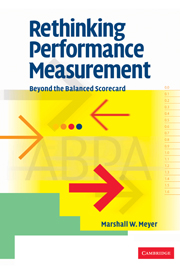2 - The running down of performance measures
Published online by Cambridge University Press: 14 May 2010
Summary
This chapter introduces the role of people in performance measurement. It explores how performance measures change as people use them. The focus, in other words, is more on what people do to measures than what measures do to people. The underlying argument is that what measures do to people causes people to behave in ways that erode the capacity of measures to discriminate good from bad performance. This phenomenon compounds the problems of measuring performance laid out in chapter 1. Managers thus face two challenges when considering performance measures. The first is finding performance measures that contain information about cash flows still to come. The second challenge is examining their measures continuously and replenishing them as existing measures deteriorate.
This chapter is grounded in several premises. The first we have already encountered: all performance measures are second-best indicators of an uncertain future, although some second-best measures are better than others. The second premise is common sense, but with a twist: people will generally improve what is measured, and sometimes, people will improve what is measured without improving the underlying performance that is sought. It can be difficult to distinguish improvement in the measure from improvement in performance because the performance that is sought lies in the future and cannot be measured directly. The third premise will be demonstrated presently: improvement in what is measured, with or without accompanying improvement in performance, usually shrinks differences in measured performance and hence in the capacity of measures to discriminate good from bad performance as well.
- Type
- Chapter
- Information
- Rethinking Performance MeasurementBeyond the Balanced Scorecard, pp. 51 - 80Publisher: Cambridge University PressPrint publication year: 2003
- 3
- Cited by

